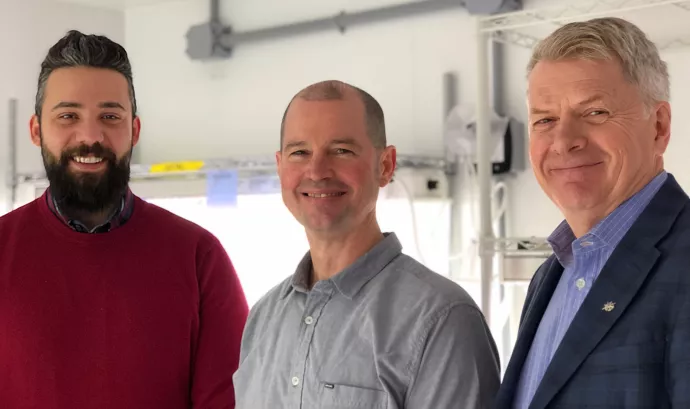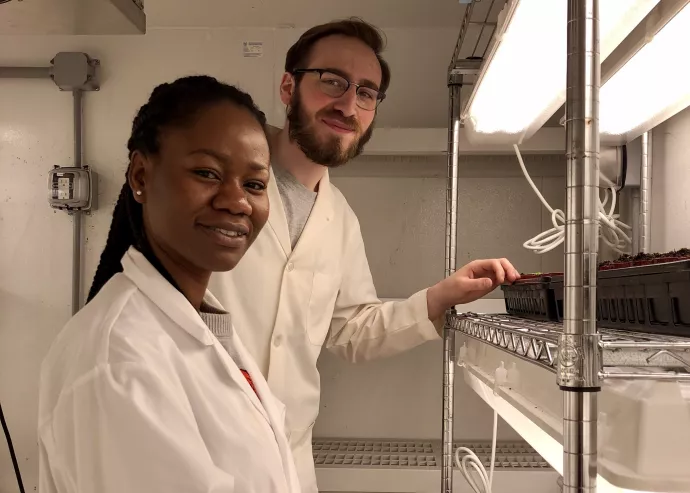An experiment in sustainability
Plant biologist Michael Phillips regarded the environmental chambers in the basement of the Davis Building at the University of Toronto Mississauga as an opportunity for an experiment in sustainability.
Phillips proposed retrofitting the chambers with LED lights to Kent Moore, Vice Principal, Research, and Ahmed Azhari, Director of Utilities and Sustainability in Facilities, Management and Planning.
“The project just fell together through a series of informal conversations with people from different divisions,” says Phillips.
The retrofit, completed in October 2019, reduced the chambers' energy consumption and greenhouse gas emissions by 40 per cent.

From left: Ahmed Azhari, Director of Utilities & Sustainability, Michael Phillips, plant biologist and Kent Moore, Vice-Principal, Research partnered to retrofit the environmental chambers in the Department of Biology at the University of Toronto Mississauga with LED light fixtures. (Photo credit: Maeve Doyle)
Environmental chambers
George Espie, former chair of the Department of Biology, says that the four environmental chambers were installed in 2009. “The installation was funded by an $80,000 NSERC Research Tools and Instruments grant,” says Espie.
The general purpose environmental chambers were fitted with standard fluorescent light fixtures. They were intended to provide a shared space where researchers could regulate environmental variables such as light, temperature and humidity.
As the Biology department’s complement of plant biologists increased, the general purpose chambers were pressed into service as plant biology growth chambers.
The chambers were filled with plant racks. Each shelf in the racks required the addition of another layer of fluorescent lights. The energy-sucking fluorescents generated tremendous amounts of heat that increased both the electrical load and the demand on the refrigeration unit to maintain the temperature. Frequent power interruptions from the external utility grid added more complications, all of which resulted in less than ideal growing conditions.
“When the power goes out for a couple of hours and then comes back on, the timers that you use to run these lights are also delayed by that same period of time. This changes the photoperiod and means that plants are exposed to what appears to be a sudden change in the season,” says Phillips.
Experiments were destroyed. Money, time and resources were wasted. By the time Phillips joined the department in 2016, confidence in the growth chambers was gone.
Team effort
Phillips, Moore and Azhari formed a partnership to investigate the issues and make recommendations. Moore agreed to put up half the funds for the retrofit and Facilities, Management and Planning provided the rest. Phillips did the legwork to find the right LED lights.
“I was happy to do it but it was surprisingly difficult,” Phillips says.
Challenges included finding suppliers that produce affordable light fixtures for plant cultivation, and finding fixtures with specific characteristics such as waterproof cases.
Phillips applied his knowledge of plant physiology to identifying LED lights that mimic natural light wavelengths, and emit the blue and red spectra most needed to produce healthy and fertile plants.
Suppliers sent Phillips sample light fixtures that he tested over six weeks before selecting the ones that produced the best growth results.
“This allowed us to make an informed choice when it came to investing some of the university’s resources into this pilot project,” he says.
It took a month to upgrade the environmental chambers with 36 LED fixtures.

Sonia Ehi-Eromosele and Ben Davis are PhD students in the Phillips lab who use the newly retrofitted environmental chambers for their research in the Department of Biology at the University of Toronto Mississauga. (Photo credit: Maeve Doyle)
The Pay-off
“The LEDs resulted in a 30 per cent reduction in energy consumption and greenhouse gas emissions. The dimming controls we installed increased that by another 10 per cent. The heat load has been cut by 50 per cent, which means less air cooling is required by the chambers,” says Azhari.
The team in Facilities Management and Planning is now working to address the momentary power interruptions from the utility grid experienced by the biology research community in Davis.
Phillips says that this project successfully contributes to U of T’s Low-Carbon Action Plan, and that the return of confidence in the environmental chambers is a bonus.
“Morale-wise, this was a big plus for the grad students who work in my lab and in other labs and who are going to use this space. To see the university invest in infrastructure to improve the quality of their research–to the students, that means the university really takes their research seriously.”
